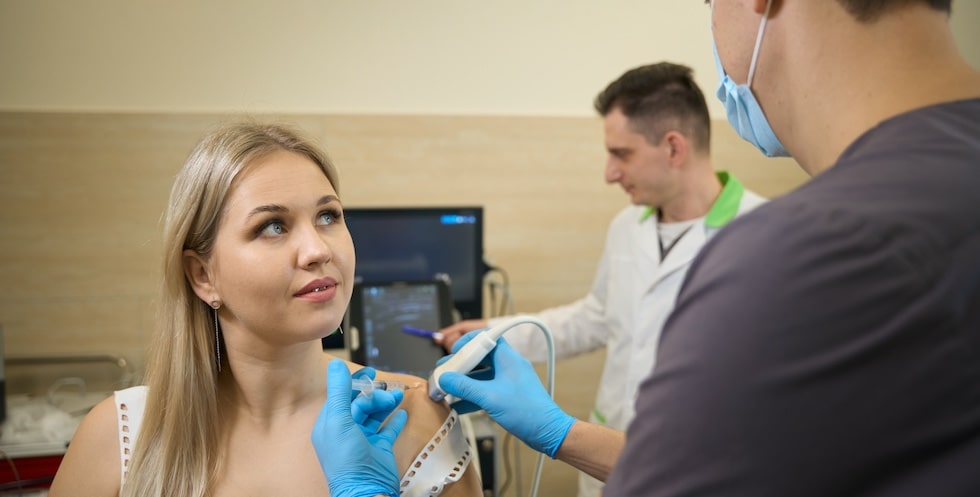Exploring Two Innovative Treatments for PTSD, Chronic Stress, and Nerve Pain
At NW Regen, we understand that the effects of trauma and chronic stress don’t just live in the mind—they imprint on the nervous system.
For many of our patients, symptoms like hypervigilance, anxiety, insomnia, or nerve pain are rooted in overactive sympathetic nervous system activity.
That’s why we offer advanced treatments that go beyond traditional medications or talk therapy—including Stellate Ganglion Block (SGB) and Cervical Plexus Hydrodissection with CPHD-D5W.
While both may be powerful tools, they serve different functions and may be better suited to different types of patient scenarios.
Here’s what you need to know about both types of procedures:
🧠 What Is a Stellate Ganglion Block (SGB)?

“By temporarily blocking the stellate ganglion,
– Dr. Ryan Wood
the nervous system gets a chance to reset.”
SGB is a targeted injection of local anesthetic (usually bupivacaine or ropivacaine – we use ropivacaine at NW Regen) into the stellate ganglion, a cluster of sympathetic nerves in the neck. These nerves help regulate your “fight or flight” response.
When trauma or prolonged stress has caused this system to stay switched “on,” the result can be ongoing symptoms of Post-Traumatic Stress Disorder (PTSD), anxiety, dysautonomia, or post-concussion issues.
The Stellate Ganglion Block is a medical procedure involving ultrasound-guided nerve block injections in the neck region targeting the sympathetic nervous system to potentially alleviate symptoms related to conditions like PTSD, anxiety, and traumatic brain injury, or TBI.
With SGB, benefits may be felt within minutes to hours, with results lasting months or even years, especially when combined with trauma therapy.
🔍 What the research says:
A recent study followed 75 patients with diagnosed PTSD for six months after receiving 2LCSB, which is the type of SGB we perform at NW Regen and they found significant improvement and long-lasting relief for the majority of patients.
Here’s what they found:
- 96% of patients showed significant improvement
- On average, PTSD symptoms were reduced by 55%
- Some trauma types—such as sexual assault and childhood abuse—showed improvement rates over 70%
- Benefits were long-lasting, not just a temporary fix

Study Highlights Long-Lasting Relief for PTSD
💉 What Is Cervical Plexus Hydrodissection with CPHD-D5W?
This treatment is part of a year-long clinical study currently offered at NW Regen for individuals diagnosed with PTSD. It involves a technique called bilateral cervical plexus hydrodissection, in which a specialized fluid (CPHD-D5W) is gently introduced around the cervical plexus using ultrasound guidance.
The cervical plexus is a network of nerves in the neck closely tied to the autonomic nervous system, making it a promising target for calming stress-driven hyperarousal in PTSD.
Unlike SGB, which aims to block sympathetic signals immediately, cervical plexus hydrodissection works by reducing nerve inflammation, restoring nerve mobility, and gradually modulating sympathetic tone.

This technique is not the same as Perineural Injection Therapy (PIT), which typically targets small peripheral sensory nerves for pain relief. Cervical plexus hydrodissection focuses on a deeper, autonomic nerve structure, offering a novel, minimally invasive option for patients with trauma-related nervous system dysregulation.
What’s in the injection?
CPHD-D5W is a regenerative, anti-inflammatory solution made of:
- Buffered 5% Dextrose in Water (D5W) – to modulate nerve function and enhance tissue glide.
🔍 Why it matters:
- CPHD-D5W is safe, non-opioid, and guided by ultrasound for precision.
- It’s part of a structured research protocol with regular follow-ups.
- Early clinical use has shown promising improvements in PTSD-related symptoms:
such as anxiety, sleep disruption, and autonomic overactivity.
🔬 Key Differences at a Glance
| Stellate Ganglion Block, Bilateral, Two-Level Cervical Sympathetic Chain Blocks | Cervical Plexus Hydrodissection with CPHD-D5W | |
|---|---|---|
| Target area | Stellate ganglion (sympathetic nerves in the neck) | Cervical plexus (deep autonomic nerve network in the neck) |
| Method | Local anesthetic, ultrasound-guided nerve block | Ultrasound-guided hydrodissection using CPHD-D5W |
| Primary use | Rapid sympathetic “reset” for PTSD/anxiety | Gradual nerve modulation, inflammation reduction, and autonomic calming over time |
| Onset | Immediate (minutes to hours) | Gradual; effects build with repeat treatments (as part of year-long study protocol) |
| Duration of effect | Months to Years | Cumulative and sustained with series-based administration |
| Formulation used | Local anesthetic (e.g., Ropivacaine) | Dextrose (CPHD-D5W) |
| Eligible patients | Those cleared for SGB based on medical screening | Study participants with PTSD who may not be able to afford an SGB or are looking to try another avenue. |
| Effectiveness | Longer history of proven effectiveness | Still in early clinical trial phase |

🌿 Which One Is Right for Me?
There’s no one-size-fits-all answer.
At NW Regen, we tailor your treatment plan based on your unique symptoms, history, and goals. Whether you’re eligible for the Stellate Ganglion Block or interested in joining our year-long PTSD study, our team is here to guide you through your options.
💬 Interested in the Study?
If you’ve been diagnosed with PTSD but for whatever reason cannot do an SGB series —you may qualify for our no-cost, year-long treatment study using CPHD-D5W cervical plexus hydrodissection.
📍 Learn more and apply here → nwregen.com/promotion-ptsd-study
NW Regen
We offer regenerative and interventional medicine – tailored to empower you with a more vibrant, active lifestyle.


